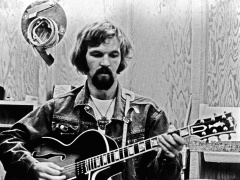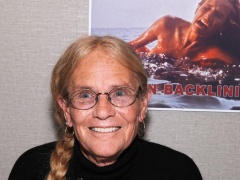
John Swenson, a veteran of rock journalism’s early years at Rolling Stone and Crawdaddy and later a chronicler of jazz, died Monday at 71 at his home in Brooklyn. He was reported to have been battling cancer for several years.
Swenson started writing about music in 1967 and became one of the most familiar bylines in music journalism in the 1970s as he moved between not just Rolling Stone and Crawdaddy but Creem, Circus, Zoo World, Rock World, Beetle, Sounds and the Village Voice.
His music writing later appeared in Spin, Musician, Saturday Review, UPI, Reuters, High Times and Stereophile, among other publications. More recently, he was a contributing writer and editor for the jazz publication Offbeat, frequently writing about the music coming out of his beloved New Orleans, where he had long had a second home.
Practically anyone who ever amassed a collection of books about rock ‘n’ roll had Swenson’s name on the spine of at least one book in their collection: the original “Rolling Stone Record Guide,” which he put together with Dave Marsh. He also edited “The Rolling Stone Jazz and Blues Album Guide.”
The most recent of his 15 books was “New Atlantis: Musicians Battle for the Survival of New Orleans,” about the soul-shaking aftermath of Hurricane Katrina, published by Oxford University Press in 2011. Other books included biographies of the Who, the Eagles, KISS, Bill Haley and Stevie Wonder.
The Rock’s Back Pages website has a collection of 109 of Swenson’s pieces, ranging from a 1971 review of the Who for Crawdaddy and the provocatively titled “Chicago: What Do You Think They’ll Call Their Seventh Album?” in 1973 to his coverage of Jazz Fest and associated artists like Irma Thomas for Offbeat in the 21st century.
In an appreciation for the Jazz Journalists Association, writer and friend Ken Franckling described Swenson as “a mentor, colleague and friend to legions of his peers, and he had a lot of them, having worked for mainstream wire services and many popular music magazines for decades. He was an affable, non-judgmental presence — with a hearty laugh, untamed beard and what he called the world’s largest collection of Hawaiian shirts. He never drove a car, but was always happy to ride shotgun.”
Swenson was also a sports writer who covered the New York Rangers for 30 years, and he covered horse racing for the New York Post and the Daily Racing Form.
In an appreciation that appeared on Myspiltmilk, friend and colleague Alex Rawls wrote, “John was part of the first generation of music writers in the late 1960s and early ‘70s who tried to find ways to write about rock ’n’ roll that matched the energy, spirit, and rebellious nature of the music. He wasn’t the stylist or the provocateur that some of his contemporaries were, but he built his career on an authentic, deeply felt passion for the music and the people who made it.”
Accolades and stories poured in on Swenson’s Facebook page.
“Perhaps my favorite story about John is the one he’d tell about being in the Aqueduct pressbox and getting Mick Jagger on the phone for a Rolling Stone interview,” wrote racing publicist Jennie Rees. “Jagger was impressed, hearing the race call in the background. I would thereafter describe John as the only guy ever to interview Mick Jagger from a racetrack pressbox.”
Fellow writer Holly Gleason described him as a “raggedy, brilliant, true-at all-costs writer who knew music inside out, and believed one must write well to be taken seriously and have a moral code to define you.”
“To watch him ditty-bop Cab Calloway-style to his favorite tunes was a joy,” wrote entertainment journalist Fred Schruers, adding that Swenson was “personally kind and supportive to so many, this then-sprout included.”
Music publicist Ken Weinstein wrote that “John was one of the elders who treated the young’ns with kindness, respect, support and patience (usually).”
Critic Wayne Robins described him as “the only music journalist I knew who could explain the Daily Racing Form, not that his tips ever helped at Belmont. Seriously, John’s valiant battle against cancer added years, maybe even a decade, to his life, against longer odds than any he ever parlayed in a Daily Double.”
In a 2012 interview with the San Antonio Current, Swenson talked about changes in music journalism since he came to a kind of fame in the 1970s. “Serious journalists aren’t being paid for their work in the way they used to be,” he noed. “Unfortunately, we are reaching a point where being a serious journalist is something that you have to do in your spare time, while you have a day job. … Downsizing only places more deadline pressure on a writer, and like any artisan writers have to weigh a tricky balance between speed and excellence. More pressure means more mistakes and less fully realized thought. Pausing for reflection shouldn’t have to be a luxury, but unfortunately it has become one. One advantage of online writing is that it can still be edited after it’s posted. But even then you have to have the time to go back and think about it.”
Swenson didn’t believe that writing too much about the technical aspects of music was advisable, even in jazz publications. “I think it is a real fallacy for people who are music students or musicians to get too involved in the technical part of what they are writing about (unless, of course, they are writing for a technical journal), because the audience is not composed of musicians. So, they’re not going to know what they’re talking about. And I see this a lot, particularly with jazz writing, where the writing gets to the point where there are too many technical issues being discussed rather than aesthetic issues. For the most part, the general audience is interested in aesthetics rather than matters of technique.”
Swenson said in the interview that “probably my favorite writer in history” was the late New York Times critic Robert Palmer, “God rest his soul. What a tremendous thinker. Now, here is someone who was a musician and understood the technical aspects of music but also understood how to talk to a general audience about music and how to relate different styles across the differences between the styles. He could talk about jazz or rock or hip-hop, because he did write about early hip-hop. He could pretty much relate any kind of style to its root elements. Music is music.”
Of younger writers, Swenson said, “I think that biggest mistake young writers make is to fall in love with their words. Writing is a job, it’s hard work. I may have known only one or two writers in my lifetime who were automatic, that could sit down and write and never have to revise’ — and he cited Lester Bangs as one of them. But of that colleague, Swenson added, “only Lester could write like Lester. I think it’s a big mistake to try to imitate that style. Everyone has to develop their own voice and Lester’s voice was perfect for its time. But I doubt that Lester would still be writing like that today if he were still around. I knew him very well and I think he would have gotten tired of writing that way, personally.”
Rawls wrote in his blog post, “I love John’s writing because he could do something I can’t. John always wrote as a true believer. He processed great music as the product of great artists, and he wanted to help more people find and appreciate their art. His desire to shed light on the people he felt deserved it meant that even when he wasn’t feeling well and wanted to dial back his commitments, his friendships and the artists he believed in kept him writing. He felt an obligation, as if no one would say what needed to be said if he didn’t, and it would be a travesty if they or their work didn’t reach a wider audience.”
Of Swenson’s more recent legacy as a writer about music in his adopted city, Rawls said, “There are at least a hundred musicians in New Orleans who experienced his profound belief in them and their music.”
Swenson is survived by his wife Barbara Mathe and his brother Edward Swenson.






